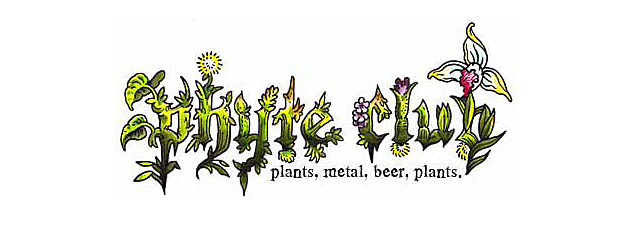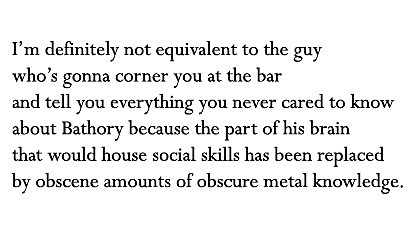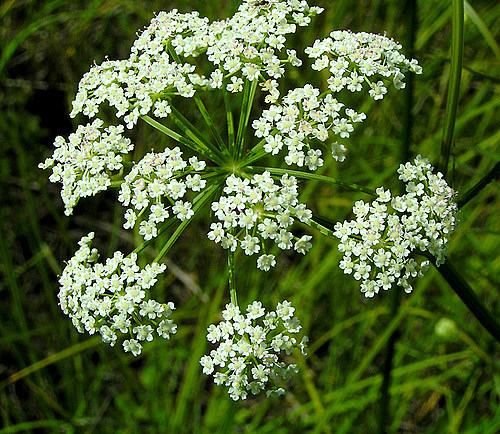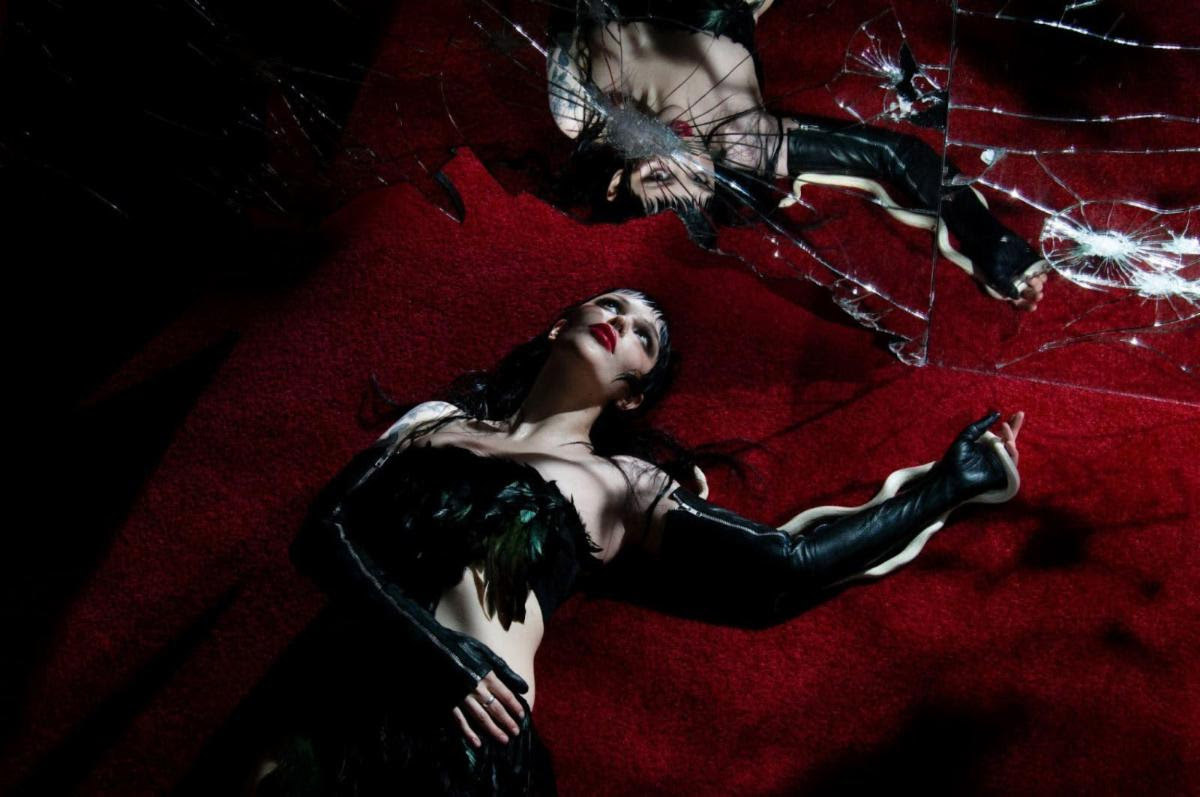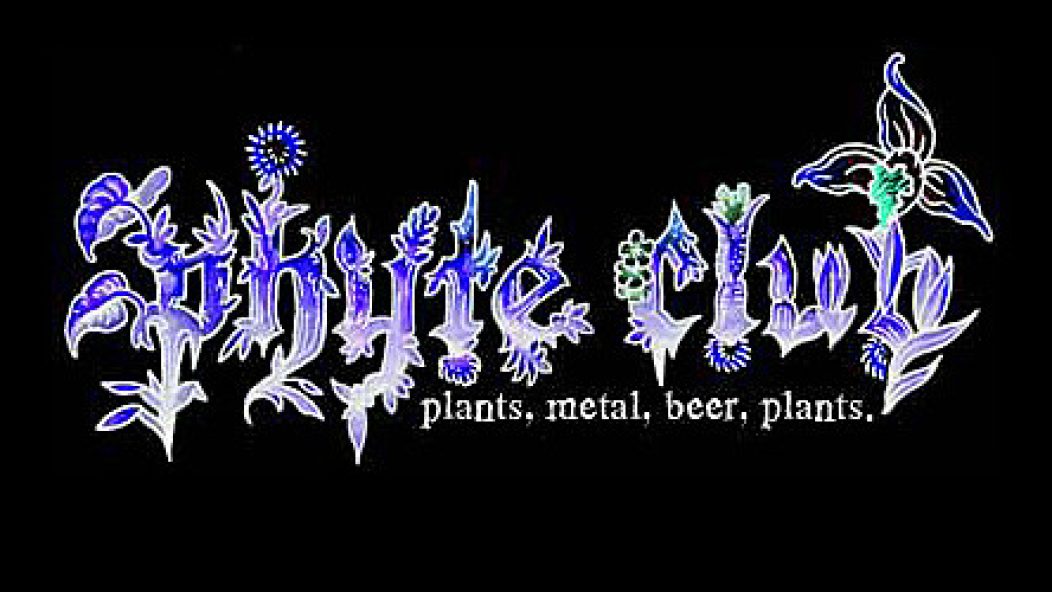
Interview: Phyte Club
. . .
At some point, I started feeling guilty about my ignorance about nature. I have all this knowledge about obscure metal band splits and seven inches, but when I walk outside, I can’t identify very large things called trees. That’s a poor show of human citizenship.
Enter Phyte Club. (Yes, I am talking about Phyte Club.) When I discovered a metal-related site that could put together a coherent sentence in English, I clung onto it for dear life. Proprietor Katie writes about plants and metal (OK, mostly plants), and shows lots of cool nature photos and leads botanical hikes that end (and sometimes start) with beer. What’s not to like?
I took advantage of her coherent-sentence-in-English ability and received the best email interview I’ve ever gotten.
. . .
How did you become interested in plants? Do you work with plants or have other “plant cred”?
I can’t remember a time when I wasn’t around plants. I grew up on the central coast of California, so I was always outdoors, playing in vacant lots, getting covered in poison oak, going to the tidepools. My first real job was at an outdoor flower stand, which was probably one of the best ways to enter a life of wage labor, and it got me knowing cut flowers. Then in college I did a 10-week backpacking trip through southeast Utah in the springtime, and the wildflowers were going off – that was the first time I really tore flowers apart with the eye of an amateur botanist, learning about how they work and trying to draw them – and I’ve since geeked out in botany and plant identification classes at community college. The botanical garden in Golden Gate Park is awesome, so I lead little kids on walks through there, trying to make things like plant reproduction at least a little interesting and understandable to a seven year-old without talking about sperm and vaginas, which is the easiest comparison and what I usually resort to on Phyte Club.
I do work with plants now, too, as one of the assistant gardeners on Alcatraz. Most people don’t even know there are gardens out there, but there are over 200 types of plants growing, survivor species the inmates took care of when it was a federal penitentiary in the 1930s and even before. All the gardens have since been restored based on old photographs and other accounts. It’s pretty insane being able to take the ferry out there and pull weeds in the shadow of one of the most infamous cellhouses in the world, with a view of the Golden Gate Bridge.
. . .

. . .
How did you become interested in metal? Other than living in the best place in the US for metal, the Bay Area, what’s your “metal cred”?
People always ask me this question, usually with their brow furrowed. I generally don’t pull out the blatant, fashionable accoutrements of the stereotypical metalhead. Of course, I kind of enjoy throwing people off like that, but at the same time it also gets frustrating seeing how people’s expectations can be so narrow. Sometimes it seems like people trade challenges and curiosity to instead put things in easy and prescribed boxes.
I feel like my interest in metal was basically a natural trajectory from the music I grew up on. My parents always had something playing, mainly ‘60s rock and early pop, Motown, psychedelia, blues, Zeppelin, Cream, anything with lots of guitar – a lot of stuff that was both hippie and heavy, which was an easy transition to Black Sabbath (which was resolutely NOT played for me while growing up, as my dad has some inexplicable disdain for Sabbath, though I’m working on him!). And I was at that perfect, junior high age when the Black Album came out, which, yeah, everyone scoffs at. But if you couldn’t be a teenager in 1984 listening to Kill ‘Em All, at least you could have a gateway album in heavy rotation on MTV when you were 12.
My Sabbath initiation came later, via a boyfriend, whom I can thank for probably the bulk of my earliest metal exposure. An encyclopedic metal-dude friend burned me Sleep’s Holy Mountain, and from there, it just sort of snowballed. Shows were how I really started seeking out metal on my own. At a point where I was pretty heartbroken and feeling lame, they filled a void. Now I get lazy about finding new albums, but I tend to like to get to know a band live best anyway. And since San Francisco is, like you said, the best place in the country for metal, I’m pretty lucky (I can always use a heads up on good new recordings, though, especially the thrashy or stoner stuff, and I love it when readers email me suggestions). I didn’t grow up going to many concerts, or even went to many in college, but now they’re indispensable. The energy keeps me going, and good metal really trumps any other live music in terms of catharsis and, I don’t know, conjuring the power of god? This is why I can’t seem to leave SF and move to some bumfuck town in the hills.
As for metal cred, can I just like the music? I’ve been writing about bands for one of the weeklies here for a few years, and on the blog for the past year. But half the time I just want to convey the, “Oh fuck, this is so good!” emotion but realize I have to put other words to it. This is admittedly why I end up writing more about the nature/plants aspect of Phyte Club and give a little less attention to the metal part. It’s easier to be articulate about some weird plant than come up with novel ways to say “pummeling”. I’m definitely not equivalent to the guy who’s gonna corner you at the bar and tell you everything you never cared to know about Bathory because the part of his brain that would house social skills has been replaced by obscene amounts of obscure metal knowledge. Plus, I don’t have any tattoos, which gives me about zero metal cred here in San Francisco.
. . .
Metal: darkness, inner worlds, constructed identities (patches, spikes, pseudonyms). How does that square with your love of nature: sunlight, outdoors, the insignificance of the self?
Completely. I feel like metal and nature are pretty synonymous in a lot of ways. It comes down to both being totally transcendent. First of all, rather than break “metal” or “nature” into these separate themes which are easy and obvious, to me it’s more an issue of energy. The rush I get from hiking a mountain in Big Sur or being a dork about some cool plant I’ve never seen before is identical to the one I get from throwing myself around to some insane riff in the front row or having to rewind that first bass note on Serpent Throne’s “Speed Queen” every single time I hear it. And both sustain me whether I’m thrilled or suicidal. That’s the whole point of Phyte Club: that two things most people think are so incongruous are actually conjuring the same vital spirit. Which is really just love, but at the risk of getting too out there, I’m not going any further with that.
But taking these dichotomies down the line, because, yeah, they are totally true in a lot of ways, there’s so much that’s “dark” to nature, to ecology. The whole basis of the food web, which is the foundation of everything, is the predator/prey relationship. Brutal in tooth and claw, right? And then – this is another thing I always struggle to find a not-too-harsh way to explain to the kids in the garden – everything dies and is food for something else: decomposition. If that’s not metal….what is? Death isn’t the cheeriest thing (unless maybe if you’re goth), but life depends on it.
The inner worlds versus the outdoors bit is valid, but it can go both ways. Metal can also be a portal to a greater community, an outsider club (originally, at least – tt can also be pretty elitist and holier-than-thou, I think), that can bring you out of your tiny, protective inner world. And the outdoors are generally associated with openness and expansion, with freedom. But being in the outdoors is also a tried-and-true way to tap into your inner world: to go on a hike and think, to work your shit out.
As for “constructed identities”, that’s a part of metal I have a love/hate relationship with. It can be fun and funny – gauntlets! Tolkien! Double-necked flying Vs! – but the pretentious shit has made me go through phases of swearing off shows, which sucks. It’s sort of the same thing with the plant kingdom, though. Taxonomists give these fancy Latinized names to new species they “discover”, and it is a way to understand the natural world through categorization. But knowing the names is really not the point. Again, it’s the feeling, and that’s beyond a label, be it corpsepaint or scientific jargon.
. . .
. . .
True, too, being in nature is a way to realize the insignificance of the self, sometimes shockingly so. And it’s really not being “in nature” – the semantics is actually important here because we are nature, and this gaping disconnect is why things are so fucked up. We are part of huge, important ecological relationships, yes, but as individuals with personalities and identities, we’re not much at all. And then if you start thinking on geologic time scales or about the incomprehensible vastness of the universe, it’s pretty ego-shattering – which is great. Yet I can also similarly lose my self in music in the exact same way. There is so much ego in metal, in music, really, but isn’t making music fundamentally about harmony and co-creation? Even the dissonant stuff!
There are other ways a love of nature and of metal overlap, too. There’s the simple volume factor. Unless you’re running your rig on solar power, all that amplification is coming from dead tree ferns from the Jurassic. Also, as an environmentalist, it’s impossible not to think about things like apocalypse, war, and religion, and get pissed off way more than is healthy. Which are all, of course, major lyrical themes, but there’s also the fact that listening to metal makes me feel better about all that crap. The heaviness of the music matches the heaviness of the state of the world, essentially. As one of the best nature writers, Edward Abbey, once said, “One of the penalties of an ecological education is that one lives alone in a world of wounds”. I think he’s sounding a tad dramatic and victimy – perhaps just because “wound” is such a crybaby word – but it can get ridiculous both studying this stuff and being unable to stop paying attention to the rampant destruction of a delusional society going on 24/7, 360 degrees. You kind of feel like it’s this constant fight to the death, even as you’re overwhelmed with the beauty throbbing from the planet all the time. Maybe I should just do more drugs to alleviate that intensity? But along with being outdoors, metal is one of the best remedies I’ve ever found. I mean, at the end of the day, what at are you going to do: kill yourself, kill everyone else, find religion, or go look at plants and listen to down-tuned guitars?
. . .
Can metal, with its gas-guzzling tours and mail-order economy, tree-killing guitars, and plastic-and-petroleum-made physical media, truly be “environmentalist”?
Yes. Or no, but it doesn’t matter because by now the idea of environmentalism has been so bastardized by this bullshit “green” consumerism that it’s a moot point. I hope this doesn’t sound like a copout, because I do think we should all try our best to have the biggest good impact and the smallest destructive one as possible. But there are two things here. One, it is going to take a fundamental consciousness shift to really, significantly stem the massive ecological meltdown humans are inflicting on the rest of the planet right now. It’s not going to be reversed or reformed little by little. You can devour all the organic, fair-trade chocolate bars you want, or buy onesies made of bamboo for your wide-eyed baby every time it spits up, but these essentially change nothing and are just band-aid efforts making the few people who can afford them feel better.
So, two: Perhaps making music that makes people feel good trumps splitting hairs over the fuel efficiency of the tour bus. I have heard of bands that tour by bike, pulling all their gear on trailers, which is great, more pedal power to ’em. But I also don’t think they had towering stacks of amps and sprawling drum kits. They were probably bluegrass bands or low-budget indie pop or something.
Which means, for the musicians making the metal, it can turn into a question of personal lifestyle choices. Are you eating crappy McDonald’s food for three months straight? Is your drug of choice decimating South American rainforests, which are hotspots of biodiversity? Are you, if you’re a dude, conceiving babies in every corner of the globe? Are you an asshole to your fans? I know that might seem unrelated, but it’s starting to seem like it’s as much about how we treat each other as how we treat the non-human parts of the planet. If we’re all content and secure enough with ourselves, for the most part, then we can move outside our personal dramas and start to look at the bigger issues.
. . .
What’s the most “metal” plant?
Definitely weed. Cannabis sativa. At least, that’s what musicians always tell me is their favorite plant. Wow, big surprise. However, from my perspective, that’s a really hard question. Redwoods always feel pretty metal, maybe just because they’re so mighty and strong. But the most? I can’t answer this, but here are some ideas. Is it the titum arum, also known as “corpse flower”, or rafflesia, two of the most massive flowers in the world which both reek of rotting flesh in order to attract carrion-eating beetles and flies to pollinate them? Or maybe water hemlock, one of the most poisonous plants in the country, which has roots that look like an edible carrot, and one small bite could off a little kid? What about the opium poppy, the coca plant, or of course, good ol’ Nicotiana tabacum? Barley and hops, half the main ingredients in beer? Then there are species that can suck up heavy metals and clean contaminated soil. This is called “phytoremediation” – Indian mustard can extract lead and Chinese brake ferns are good for arsenic – I would throw these plants some horns any day; they’re literally made of metal. Or what about carnivorous plants that drown insects and even rodents in their hollow leaves, then use their digestive enzymes to break them down to get nutrients?
There are a couple species of nightshade with half-inch spikes growing down the center of their leaves (for anyone in San Francisco, there’s a huge one growing at the top of Buena Vista Park). Mahogany and maple trees have been sacrificed for many a Gibson. California Indians used (and might still, for all I know) the black juice in poison oak stems for facial tattoos, which kind of makes anyone getting a modern gun-and-ink tattoo seem like a pussy in comparison.
There is so much diversity and weirdness in the plant kingdom, I obviously can’t even answer this question. I can say, though, that the philodendron right in front of my speaker is growing like crazy, so that invalidates the argument that plants will only grow to mellow music!
. . .
Water hemlock
Photo by jlucier
It will kill you
. . .
Likewise, what metal bands/albums/songs best express, whether sonically or lyrically, nature’s energy?
For me, it’s mainly sonically, a handful of songs that really express the vitality of nature. Songs that are powerful, fierce, bursting with energy. The force and constant driving drums propelling “Sons of Thunder” off High on Fire’s third album is a favorite. I’ve often daydreamed about doing a heavy metal Baraka or Microcosmos, if I had any film skills, showing things like time-lapse recordings of plants growing or pollination and then massive clear-cuts or dead zones in the ocean from algal blooms. “Sons of Thunder” would probably be the cornerstone of the soundtrack and, because I’m a total sucker for dual harmonized guitars and galloping, Saviours and Iron Maiden would figure prominently, too.
Actually, High on Fire’s first two albums, starting with that slippery, deep-seated riff of “Baghdad”, are both up there. They’re both so fucking rooted and at the same time take you off in some other universe. “F Subzero” and “Sleeping Beast” off Saros’ Five-Pointed Tongue kill me – it’s such a bummer they’re not playing anymore, but Vastum and Hollow Mirrors are great. I can’t help but like Arkona despite the pagan cheesiness, with Masha’s screams that sound like she’s channeling the woe of the Earth, especially the part where she comes back in after all the lilting rubberband sounds mid-way through “Pokrovy Nebesnogo Startsa”.
So there’s the incessant movement in death and thrash that parallels nature big time for me, and then there are the crying bent strings and soaring leads of bands like Serpent Throne and The Fucking Champs. The more stoner metal stuff calls up the more “lie in a meadow and trip out on the sun” energy. Acid King feels like floating in the ocean to me, for example.
Of course, there are the bands that are vocal about being into nature, whether it’s the bioregional black metal of Wolves in the Throne Room, or Gojira with their environmental bent. I love “Blackened”: “See our mother! Put to death!” And “Green Manalishi” covered by Priest, which isn’t so much about nature per se but about one of the biggest the reasons we annihilate it: money.
But as far as lyrics, Sabbath really said it best. “Show the world that love is still alive you must be brave / For you children of today are children of the grave, yeah!” is probably the most environmental lyric ever written. Or maybe, “Of all the things I value most of all / I look upon my earth / And feel the warmth / And know that it is good”. It’s a tie. Oh wait! But I almost forgot the very first heavy metal ode to a plant, duh: I love you, sweet leaf.
. . .
Do you meet many other people with similar interests in plants and metal?
Many? Definitely not. A few, yeah. But those few are pretty impassioned, and tend towards the weird-in-a-good-way, so what doesn’t happen in quantity is made up for by quality.
I’d always felt like these two passions were segregated in such separate realms. I’d go to shows and get frustrated with the scene-y shallowness, and then I’d go to class at the botanical gardens a few hours later, my ears ringing and my neck searing, and I’d laugh because I was in a room full of retired people. Both were fine enough in themselves, but I’d trip out because I felt split. Of course, it’s not like it’s essential to hang out with people with identical interests, but I thought it would be nice and a funny sort of challenge, an experiment, to see if I could find some. I wanted to learn about plants AND party, dammit! So I started making up these “environmetalist” adventures, just to tap into this combination more even if it was on my own. I think the first was hitting up High on Fire at the Blank Club in San Jose, making it a point not to get drunk so I could arrive in Big Sur at four a.m., camp, and then hike Mount Manuel the next day. They would just be these balls-out mini-vacations, trying to cram enough epicness into however long I could get off work as possible, and always trying to balance not partying too much so I wasn’t worthless during my time to be outdoors.
I remember once complaining to a friend in the music industry that I couldn’t find any friends who wanted to rock out and cared about exploring nature, too. He scoffed and was like, “Yeah, of course not. Good luck!” I knew he was being reductive. but that was the point where I went, “Fuck you, yeah I will!” Soon after I met my friend Kelsey on the first day of Environmental Horticulture class when she noticed one of my band hoodies, and from there it was on. In class we were pretty much very engaged versions of Beavis and Butthead, never failing to giggle about the pine tree genus – “She said ‘Pinus’, huh huh huh” – and that was where I came up with the term “Phyte Club”, just messing around passing notes back and forth. At one point. we did a presentation on deadly plants that incorporated candles, goblets full of wine, velvet cloaks, and Saint Vitus! After class we’d spend the rest of the day tromping around the City, ID’ing street trees and plants in people’s gardens, usually ending up at bar or a show. It became a question of, “How can I do this all the time?”
. . .
Arkona – “Pokrovy Nebesnogo Startsa”
. . .
So Phyte Club has definitely generated some interest from people who like both. Earlier in the year, I organized a couple of hikes, where we could talk botany, drink on the trail, and talk about our favorite albums. People were into it, but right now I’m working so much that when I have a rare chance to hike, it’s going to be by myself. The environmetalist adventures live on as much as possible, though. In April, Kelsey and I used the Big 4 as an excuse to hit up the Carrizo Plain, Joshua Tree, Pinnacles, and points in between. (And just for the record, yeah, we totally shook our butts like those two girls y’all mercilessly made fun of in that video. It was awesome.)
However, there is the, “Do I have to like metal to like your blog?” sentiment occasionally from the exclusively plant people. Which is hilarious because there really isn’t nearly as much music coverage on it as I ideally want. It’s just ridiculous: I am unconvinced people are that one-dimensional. So Phyte Club is like my version of a big, if polite and slightly passive-aggressive, middle finger to narrow-mindedness. The point is to share the things that get me off, that I find inspiring and think other people might, too. It’s not necessarily to transform a blasé metal dude into a treehugger or get all the gardeners I know to fall in love with Slayer. I don’t know if anyone will really give a shit, but I’m having fun with it, and if people learn something cool about a plant or get turned on to some band they’ve never heard of or think about their relationship with nature in a different way, so much the better.
. . .
Metal’s biggest festival is Wacken, which over 80,000 attended last year. What’s the plant equivalent?
The Amazon. There are plants growing on plants growing on plants, species we don’t even know about. I haven’t gone yet, but it’s actually not high on my list of rad botanical places to visit. I just can’t hang with the humidity and biting bugs and gazillion species of vipers. I’m more into the Mediterranean climates – the California coast is one of them, and there are four others: South Africa, parts of Australia, the Mediterranean basin, and the central coast of Chile (which is basically California upside-down). They all have long, dry summers and rainy winters with no frost, and plants that grow in one tend to do well in the others, too, because they have similar adaptations, which is why there are so many species from these other places in, say, San Francisco. These regions have an incredible amount of biodiversity, totally disproportionate to the tiny amount of the globe they take up.
Last year, I spent the entire fall planning a two-month trip to Chile to look at plants, talk to botanists, and check out the Chilean metal scene. One of the original intentions with Phyte Club was to use it as an excuse to travel to far-off lands, maybe even one day morphing into leading botanical tours or something. The Chile idea fell through, though, in part because I chickened out, and also I got the gardening job on Alcatraz, which was too random and cool to pass up. I was pissed, though, because Motörhead ended up playing in Santiago in April. I was also trying to work something out with the Canary Islands and Portugal in tandem with Hellfest, but that was just absurdly expensive. So now you know, when I lag on the blog, there’s a good chance it’s because I’m instead planning some insane trip I may or may not take!
So I haven’t gone to the Amazon or Wacken, but if anyone wants to organize some epic adventure to follow some band around on tour or go to a festival while checking out renowned botanical hotspots, hit me up. I have no idea how to afford such excursions, but maybe I’ll either get hired as a merch girl or Phyte Club could get sponsored by Scion, ha ha.
. . .
. . .
The last educational experience most of us had with plants was probably high school bio (or a new weed dealer). Where should we start – aside from your blog, of course?
It’s so easy. Really, it’s just an issue of quality of attention. You don’t need to take a class or open a book. Just open your eyes, get off your iPhone, and look at what’s around you. I’m really privileged to live in San Francisco because I don’t have to rely on a car, so I’m always either on my bike or walking, which slows me down to a level where I can actually consider what’s going on in the rest of the world. If you have a natural curiosity about things and how they work, that helps, too.
Also, if you have specific questions, email me (katie at phyteclub dot org). People send me photos of plants they see and need ID’ing all the time. I don’t always know the answer, but I’m happy to at least look for it.
. . .
Why is it important for metalheads (or anyone) to know about plants?
There’s the big picture, the web of life. But then there’s just the bare-bones utilitarian aspects of plants, why we need them for survival.
I’m going to pull out some more little kid environmental education stuff, the basics: Do you eat plants? Are you wearing plants? Do you live in a house made of plants? Do you get medicine from plants? What are you breathing right now?
And for metalheads, specifically? Electric guitars are powered by and made out of them, you should bring bouquets of them to your girlfriend or boyfriend when you get home from tour, and most of us enjoy some sort of recreational drug that is a plant or made of one. You wipe your ass with plants, don’t forget.
. . .
. . .
